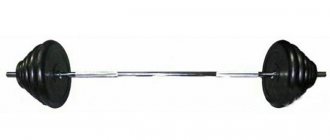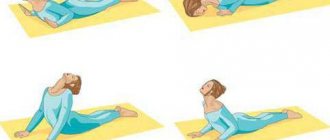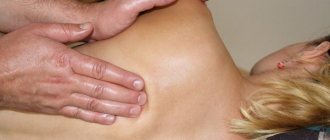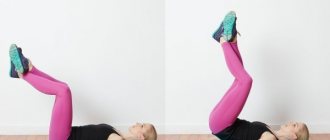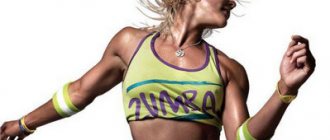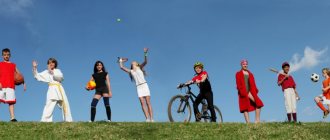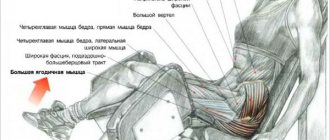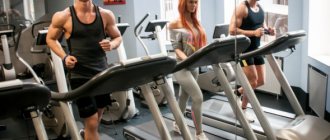The need to prepare for stress
Before the main workout, you need to do a warm-up in any conditions: during exercise on the street, in the gym, at home. Getting started correctly will take 10-20 minutes, but will help you get in the right mood for the next lesson.
What does warming up do before any workout:
- The joints of the musculoskeletal system begin to work, warm up, stretch and avoid damage during any serious exercise.
- The cardiovascular system is adjusted to work and prepares the entire body for increased stress. But it is worth considering that the pulse should not rise above 100 beats per minute.
- Slow preparation improves blood circulation in all internal organs by about 70%, due to which capillary vessels dilate and blood flow improves. All these changes trigger a metabolic program.
- Adrenaline begins to be produced in the blood, and it helps to better cope with intense training.
- In addition, warming up prepares the body on a moral level. Simple workouts help you concentrate and get ready for a long workout.
- Simple exercises stimulate brain connections at the neuronal level and stabilize the nervous system.
An effective set of exercises for warming up at home
You can achieve excellent results not only in the gym. It is quite possible to get yourself in order at home, even if you live in a multi-storey building with poor sound insulation and do not have auxiliary equipment. In this case, jumping and running in the apartment are not available, but you can warm up in another way. Remember and perform the following complex:
- Walking in place. Starting position: standing, arms pressed to the body, feet a short distance from each other. Walk in place at an average pace for 3-4 minutes.
- Raising the knees to the level of the pelvis. Do 30 times in 30 seconds.
- Squats – 15 times. Remember that your knees should not go beyond your toes; emphasis should be placed on your heels. When lowering your body, move your buttocks back and tilt your back slightly forward, keeping your spine straight.
- Triceps stretch – 4-5 times on each side. Raise your arm and bend it at the elbow. Bring your forearm back. With your other hand, apply gentle pressure to your elbow, stretching the muscle.
- Shoulder rotation – 12 times forward, 12 times back.
- Stretching the pectoral muscles – 8-10 times. Put your hands behind your back, rest your hands on your lower back. Fingers should point down. Push your pelvis slightly and push your chest forward.
- Stretching the back muscles – 6-8 times. Clasp your hands and place them in front of you. Round your back and reach your arms forward.
- Stretching the thigh muscles – 5 times with a 5-second delay. Bend your knee and lift your foot to the level of your buttocks. Hold the sock with your hand and gently stretch the muscle tissue.
To make muscles more pliable, they need to be warmed up. Trainers recommend starting with a short warm-up, followed by stretching and the main system of exercises. The final stage is a full stretching of all muscles. This approach will help avoid pain in the muscle mass, improve relaxation and increase their endurance.
Even if you are not a professional athlete, but stretch for your health and pleasure, take a little extra time to warm up your muscles. This will speed up blood flow, and the exercises themselves will not take much time and effort. For example, easy walking or rotation of the arms, pelvis, head, etc. Main goals:
- tone the entire muscle group, increase the temperature;
- reduce overvoltage;
- improve muscle elasticity;
- reduce the load on the heart by increasing cardiovascular activity;
- increase heart rate;
- increase the intensity of the training process;
- reduce the risk of overextension, strain and injury;
- Warming up allows you to psychologically prepare for the stretching process itself.
When muscles are cold, there is a risk of injury when performing exercises with excessive speed and force. This is the opinion of most professionals.
- Everything is done at a slow pace. Rushing does not promote relaxation, but on the contrary, can lead to injury.
- First, take on simple exercises, gradually adding new ones, each time a little more complex.
- The duration of the warm-up is up to 15 minutes, and not until exhaustion.
By following all the rules of stretching, you can avoid side effects. Experts advise that to warm up the muscles, it is better to perform exercises similar to the main system of physical activity, but at a more relaxed pace. Movements aimed at warming up the muscles must have a certain sequence.
Is it possible to achieve a successful result without using additional weights?
Many people know that only those workouts that take place with the use of additional weights can help in increasing muscle mass and increasing strength. However, there are simply a huge number of reasons why there is no desire to train with additional weights. And this is where the question arises about whether there is a set of exercises without weights.
It is necessary to face the truth - there are situations when a person simply cannot go to paid gyms. There are also athletes who do not need huge muscles. They are primarily interested in increasing strength and endurance. In addition, a set of exercises without weights can be performed almost anywhere and at any time, keeping your muscles toned.
The first stage is cardio exercise
In the classic version, any workout begins with cardio. Spend 10-15 minutes on a treadmill or elliptical trainer. You can try jumping rope or other intense cardio exercises. The running time depends on the type of exercise that follows. If you are expecting strength training, ten minutes of warm-up is enough, you don’t need to bother. And for those who intend to lose weight, it is better to run and jump for more than the average time - at least twenty minutes. The goals of cardio exercise are to raise body temperature, supply blood to the muscles and bring the body into a state of full readiness.
What are the dangers of not warming up?
By not warming up, you increase the likelihood of injury. In power sports, this causes at least half of the damage. The most common problem among athletes of any level of training is sprained ligaments. This injury plagues athletes from many sports: crossfit, powerlifting, martial arts, football, etc. During the warm-up, your ligaments become more elastic and better absorb the force load.
Joint injuries are slightly less common. The most affected areas are the knees, elbows, hands and shoulder joints. Spending 10 minutes doing rotational exercises, low-weight assistance exercises, stretching, and a couple of warm-up sets with an empty bar or light dumbbells will reduce your risk of injury to almost nothing.
In the long term, not warming up has a negative impact on your cardiovascular health. The heart is also a muscle, and it needs to be trained. You just need to do this smoothly and gradually, so a light cardio warm-up is an integral part of any well-structured training program.
Stretching classes for children
Stretching is useful not only for adults, but also for children. Stretching in childhood is important. It develops joint mobility. Stretching classes for children are conducted in a playful way. The training is accompanied by music and an interesting story.
This develops the child’s attention, concentration, and imagination. Children's stretching is based on static exercises
They are performed at a moderate pace.
Its benefits are:
- improving joint mobility;
- development of muscle flexibility and elasticity;
- improving activity;
- formation of correct posture.
To prevent the child from getting bored, the lesson lasts 35-40 minutes. The number of repetitions of each exercise varies depending on age. At 3-4 years old they repeat 5 times, at 5 years old – 7 times, at 7 years old – 10 times. All exercises are quite simple.
Game stretching for children:
Basic warm-up exercises
Preparatory exercises belong to the category of general developmental exercises. They do them regardless of where and what they will do: train at home, on the street or in the gym, swing or do stretching, load themselves with plyometrics or any type of fitness aerobics, run, walk with Nordic poles, ride a bike, swim .
The gold standard for starting a warm-up is a 1-2 minute cardio warm-up: light jogging and/or several intense types of walking in place.
Gymnastics for joints
The joint vortex warm-up from kung fu is considered a classic of the genre. Perform circular movements 8-16 times in each direction:
- toe (standing on one leg);
- knees closed (feet together, body tilted, palms resting on knees, you need to sit down a little while moving);
- open knees, asymmetrically inward and outward (feet shoulder-width apart, palms on knees bent at 45 degrees);
- the pelvis, and to increase the amplitude, you can “in counterbalance” use the shoulder girdle;
- shoulders;
- at the elbows, rotating the forearms in a mirror manner (arms to the sides);
- with hands or fists (arms forward or to the sides);
- head (feet shoulder width apart).
These simple movements will warm up the deep ligaments and increase the production of synovial fluid, which will protect the cartilaginous surface of the joints from deformation.
Warming up the muscles
Next to the joints, you should warm up the muscle fibers and ligaments. To do this, perform dynamic general developmental exercises, the bulk of which are turns, bends, lunges and squats.
Muscle warm-up before strength training or other type of training is designed to increase the activity of physiological systems that are responsible for muscle function and increase temperature homeostasis in them from 34 to 37.5 ° C. It should be performed until you sweat, but without fatigue. The heart rate at the end of this part of the warm-up should not exceed 130 beats/sec.
General developmental exercises are the same for all sports, but the number of exercises for a particular muscle group still depends on the work ahead. For example, before running, you should pay more attention to your legs, and before strength training for deadlifts, you should pay more attention to your back.
Stretching before exercise
Stretching is necessary not only to increase the elasticity of muscles, ligaments and tendons. It enhances the interaction of muscle fibers and improves intermuscular coordination.
Unlike the joint warm-up, where martial artists practice working the joints in the “bottom-up” direction, in stretching before training they advise “moving from head to toe.” At the same time, it is recommended to do several different ones or increase the number of repetitions of the same exercise, for parts of the body that will experience the greatest load.
The order of isometric (tension followed by stretching) warm-up:
- trapezoid - turns, tilts of the head;
- pectoralis major and minor, and then long back muscles - work at a vertical support;
- triceps;
- posterior delta bundle;
- lateral muscles of the trunk and limbs - bending to the side with raising the arm;
- short and long heads of the biceps (back surface) of the thigh;
- quadriceps;
- gluteal muscles;
- calves and Achilles tendon.
The warm-up before training in the gym ends with ballistic swings, difficult coordination jumps, and a 3-minute cardio load. After a moderate-intensity run, you need to restore your breathing, and you can start training.
Half-over breathing
Similar to the previous exercise, you should not perform it with heavy weights, since it is intended to stretch the pectoral muscles after training. We do 1 - 2 approaches with 12 - 8 repetitions.
These exercises will be more than enough for you to increase the muscle mass of your pectoral muscles; you should not do all this in one workout, as your body may simply not withstand such a load.
Here, I have tried to indicate most of the small and large, deep and superficial muscles involved in weight training. But it is not enough to know the location and name of the muscles; it is important to know their function. To do this, it is advisable to study not only and not so much anatomy, but functional anatomy. In the “list of recommended literature” posted on the main page, I indicated useful reading in this regard. Also, my articles on exercises contain some minimal information on functional anatomy (in particular, small excursions into the functional anatomy of the muscles of the chest, shoulder girdle, and muscular “corset” of the torso are in the articles on the corresponding exercises, so I did not duplicate them here This material can be found in the exercise articles). And here I provide some information about:
- deep muscles (and not just superficial ones, which almost everyone who trains with weights for more or less a long time knows about);
- functional groups - associations of muscles not only and not so much by anatomical location, but by the function that unites them;
- muscle balance of antagonist muscles, as an aspect influencing posture.
The information I presented is by no means complete, but on the contrary, quite fragmentary - since I did not set out to present complete material for study, but only wanted to give a general idea of what’s what, for independent search for complete information on the issues raised here (if it seems interesting).
General anatomy
Functional anatomy
The presented movements and their characteristics in the shoulder joint are completely similar to those in the hip joint, with the exception that the range of motion of the hip is limited exclusively to movements in the hip joint, since it is located on a fixed bony pelvic ring, and not on movable structures (scapula with the collarbone), like the shoulder joint.
Some functional groups and functional combinations of muscles (synergists) to perform certain movements (exercises)
Little is usually said about the hip abductor muscle complex, and in particular about the main one, the gluteus medius muscle. Exercises on them are usually not specifically done (and there are no special exercises, except for leg abduction), and there is really no need for this, since these muscles work constantly and very intensely both in everyday life and during training with weights. Here is an excerpt from one textbook on anatomy: “The gluteus medius muscle, a paired muscle, forms the lateral surface of the pelvis: starting from the lateral surface of the ilium, it tapers in a fan-shaped manner and attaches to the greater trochanter. The action is twofold: 1) strongly straining on one side with a fixed pelvis, the muscle moves the thigh (and leg) to the side (for example, in ballet). Contraction of the front part of the muscle rotates the thigh around the longitudinal axis to the inside - turns the extended leg with the toe inward. Contraction of the posterior part of the muscle rotates the thigh toe-out; 2) keeps the pelvis and torso at the hip joint from falling in the opposite direction. This work occurs constantly: when standing or sitting, the right and left muscles, straining simultaneously on both sides, support the pelvis, and therefore the torso, in an upright position, regulating its oscillations to the sides. If a person leans on one leg and the other is raised, as when walking, the muscle becomes very tense, as it supports the pelvis, and therefore the torso, standing on one leg, from falling in the opposite direction. When walking and running, the gluteal medius muscles alternately tense, holding the torso, which hangs on the supporting leg. This tension of the gluteus medius muscles alternates quickly when walking, and even faster when running.”
Considering the above, I will add that the basic exercises for the gluteal medius muscles can conditionally include alternating lunges with one leg, with a barbell or dumbbells - the load on the gluteal medius muscles will be “killer”, unattainable with the usual profile abduction of the leg, even with resistance ( for example on the lower block).
The nuances of the structure and attachment of the gluteus maximus muscle - the strongest muscle in the body
Video on the topic:
An excellent video demonstrating the joint work of almost all the muscles involved in squats: knee extensors (quadriceps), hip extensors (ischiopopliteal, gluteal), ankle flexors (gastrocnemius, soleus), as well as the stabilizing function of the spinal extensor muscles and abdominal muscles in this exercise ( Only the adductor magnus muscle of the thigh is not shown, the back part of which is involved in hip extension along with the ischial-popliteal muscles, but this does not change the essence - the video is excellent)
In general, on the site from which these videos are, there is a lot of useful and interesting information on functional anatomy, as well as There are many videos from this site on YouTube - I highly recommend it.
Posture (muscle balance of postural muscles)
In this section I will give some of the most common causes of poor posture associated with hypo/hyper tone of the so-called. postural muscles, i.e. muscles, in addition to providing movements that provide with their tone the natural physiological curves of the spine and the tilt of the pelvis, influencing them directly or indirectly. For example: the pectoralis major muscle, through the humerus and collarbone, pulls the entire shoulder girdle forward, while bending the spine in the thoracic region; and the ischial-popliteal muscles directly pull the pelvis from behind, turning it on the head of the femur and tilting it back, and together with the pelvis, the spine motionlessly connected to it changes its bend, etc. The muscles of posture are the pectoralis major muscles, the muscles that fix the scapula , abdominal, pelvic and thigh muscles, spinal extensor muscles.
Conclusion:
In this article, if you can call it that, I tried to give a very general and approximate idea of the human muscular system, the study of which, if not necessary, is very useful for all those training with weights. As for the last section (“posture”), the information provided in it is very superficial and cannot be used to compile exercise therapy complexes, with or without weights - correction of posture with the help of physical exercises is exclusively within the competence of certified specialists, after examining the patient the components and prescribing a set of exercise therapy exercises. The information I provided in this section, incomplete and very superficial, is part of the general information about the human muscular system given in this article.
Additionally:
A little about musculoskeletal levers and pulls
The same applies, for example, to the deltoid muscles - the height of their attachment on the humerus, the ratio of the muscle and tendon parts, which determines both the appearance and certain nuances of the technique of performing basic exercises (for example, it is more convenient for someone to do a standing/sitting bench press from the chest with a wide grip - transferring most of the load to the deltoids, and for someone in the middle - evenly distributing the load between the triceps and deltoids).
Understanding the physical and mechanical aspects of musculoskeletal levers and pulls in relation to training with weights is, of course, not necessary - usually the optimal technique for performing certain exercises is determined practically as the most convenient and powerful (intuitively). Moreover, the length of the muscles (the place of their attachment on the bone relative to the joint), bone levers, the ratio of the belly of the muscle and its tendon part - all this is genetically determined and is not subject to changes due to training, and in training it only makes sense to adapt to the individual characteristics of the bone structure -muscular system.
Therefore, I only briefly touched on this topic, which is “dead” without practice, and with practice comes an understanding to one degree or another of physical and mechanical theory (especially since the school course in physics and mechanics contains everything necessary to understand this aspect weight training, information).
Hello! I remember the times when I studied at technical school. Our director was a very healthy man and he had a friend whom he often made fun of. And he laughed because his friend could not scratch his back with his hand - he had such huge “bits”. Since then, if I see men with overly huge hands, I immediately think about how difficult it is for them to scratch their backs. Well, jokes aside, these are the hands that most bodybuilders strive for.
For me, as for most other visitors to rocking chairs, hands are my favorite part of the body. I don’t know why, but I always really liked training them. I don’t remember any problems with them, they grow normally. And when I decided to check with a measuring tape, it turned out that my arm circumference corresponded to the circumference of my shin - and this is how it should be. And then I was generally happy.
I was never seriously interested in the anatomy of hands. But in vain. This can really have a big impact on the result. When you know where each muscle is located and even what it is called, you can pump up this muscle group at a higher psychological level. Additional motivation and some awareness appear.
You feel a surge of strength and the intensity of your workout increases. It becomes interesting to pump your arms. Be sure to read about the importance of psychological aspects in bodybuilding!
If you want to have strong, sculpted, pumped up arms, then you also need to know not only the practical part, but also the theoretical one. After all, this is the foundation. The theory will help you better understand your body, know the anatomy of your arms and which exercises are best for muscle growth. All this will make it possible to conduct more productive training.
Arm muscles anatomy, basic concepts of proper training of each arm muscle - this is exactly what you will find in this article. Well, let's get started already.
Although arm muscles occupy about 5-7% of a person’s total mass, they are a very important component of a harmonious and aesthetic body. They are often involved when pumping up other muscle groups.
The arm muscles are divided into shoulder and forearm muscles. And this is what they are:
- SHOULDER MUSCLES.
They are divided into the anterior group (arm flexors), which includes the biceps (our biceps), brachialis and coracobrachialis muscles. And on the back group (extensors of the arm), it contains the triceps muscle (which we call triceps) and the olecranon muscle. - MUSCLES OF THE FOREARM.
Everything is much more complicated here. This part of the arm has the greatest variety of muscles. The most basic ones that affect the mass of the forearms are the following: brachioradialis, flexor carpi radialis and ulnaris, extensor carpi radialis, flexors and extensors of our fingers, pronator teres.
Now let's look at the most basic large muscles separately and the basic features of their training.
Features of individual exercises
To get the benefits of stretching exercises, you need to take a responsible approach to performing them correctly. Let's look at the features of performing some exercises:
- Bend forward. You need to stand in a standing position, spread your legs at a distance of 30 centimeters and raise your arms above your head. It is necessary to bend down as much as possible and at the same time try to touch at least the tips of your fingers to the floor between your legs. You should keep your knees as straight as possible, but it is not necessary. Repeat the exercises several times.
- Raising your knees. While in a standing position, bring your legs together. First, take your left leg in your hands, pull it to your chest as much as possible, clasp your knee with your hands and freeze in this state for about 30 seconds. The back should be as straight as possible. A similar action must be done with the other leg.
- Lateral bends. To perform lateral bends, you need to take a standing position so that the distance between your legs is approximately 30 centimeters. Start smoothly sliding your right hand along your left thigh until you go all the way down. At the same time, make sure that your back is as straight as possible. After this, you need to do a similar exercise with the other leg.
- Rotational movements of the arms. The exercise is performed in a standing position, with your feet shoulder-width apart. First straighten your left arm and smoothly, slowly make 7 circular movements in both directions. Similar actions must be performed with the other hand.
- Raising the body. Take a lying position, legs together, hands at your sides. First, you need to carefully raise your shoulders and head and look at the tips of your legs. This exercise must be performed at least 8 times.
- Exercise "Boat". Take a position lying on your stomach, place your palms under your hips and always along your body. At the same time, you need to raise your right leg, shoulders and head. After this, we proceed to take the starting position and perform a similar action with the other leg.
- Pushups. This exercise can not be performed completely, but you need to start with at least partial push-ups. Lie on your stomach and place your hands under your shoulders. Try to rise at least a little and straighten your elbows.
No matter what range of pre-workout exercises you choose, they will all be effective if performed correctly.
Some benefits of trained hands
- Statistics show that one of the first things girls pay attention to in a man when meeting or getting to know him is his hands, and this is not surprising. Perhaps this is due to the fact that subconsciously a woman feels protected when next to her is a strong man with large muscular arms who will not let her be offended. Although hands are far from the most important factor that girls pay attention to.
- You will be physically stronger and will be able to use the strength of your arms in an emergency. Also, this is some kind of protective factor, since it is unlikely that anyone will want to snatch the phone from a guy with big “banks” in the next alley. Well, maybe the Gopniks will have even bigger jars))).
- For a woman, strong arms are also an advantage, as it will be easier for her to cope with everyday physical activity. For example, carrying bags or holding children.
With this, I conclude this note with full confidence that you have gained useful knowledge that will now increase your level of training awareness. Study anatomy and other muscle groups, which I will definitely cover in the future. To make sure you don’t miss anything, subscribe to the blog and if anything is unclear, always ask in the comments below. That's all. See you again, friends.
P.S.
Subscribe to blog updates
so you don't miss anything!
I also invite you to my Instagram.
If you are wondering which exercises are intended for which muscles, then I hasten to please you. On this page you will find the most effective exercises for all muscle groups, which will help you not just harmoniously develop your body, but really pump up your muscles. In addition to a description of the technique, each of the exercises is accompanied by photographs and videos, with the help of which you can master all the subtleties and nuances.
Trapezius To pump up the trapezius muscle, you need to work it in three directions. You need to complete at least three exercises: one for each part. The trapeze has natural power, which is why fairly heavy weights should be used.
Deltoids (shoulders) The deltoids are located on one of the most fragile joints in the body. Therefore, there is no need to use excessively heavy weights; the main thing for the progress of deltas is the correct execution technique.
Pectoral muscles To pump up all the chest muscle bundles equally well, they need to be worked from different angles. Training should take place 1-2 times a week. If you pump your pectoral muscles no more than twice a week using the exercises presented here, you will definitely achieve the results you need.
Back muscles The back is a combination of large muscle groups and in order to effectively load them you need to try hard. If you want to build up your back muscles, then you should use weights that allow you to do no more than 8 to 12 repetitions. It’s really hard to pump up your back, but with the right approach it’s quite possible.
Biceps Consists of two heads: the short one is responsible for mass and volume, the long head gives that very “peak” to the biceps. Therefore, in order to effectively pump up your biceps, you need to choose several exercises in order to load both heads equally well.
Triceps The majority of newcomers to the gym pay more attention to the biceps, but they need to know that it is thanks to the triceps that the arms look more massive even in a relaxed state. And if you want people on the street to say, “Oh, those arms he has,” then you need to pump your triceps just as hard.
Forearms If you want to pump up your arms well, then the muscles of the forearm should be treated with the same attention as other parts of the body. Thanks to well-pumped forearms, the arms become more voluminous and proportional in appearance.
Abdominal muscles Every man wants to pump up his abs with a six-pack, and almost every woman dreams of having a toned, beautiful stomach. To achieve ripped abs, you not only need to perform countless repetitions, but also eat right.
Leg muscles In order for the legs to be harmoniously developed, it is necessary to train each of its muscle groups with full responsibility: buttocks, quadriceps (extensors), muscles of the back of the thigh (flexors) and lower leg muscles (calves).
Triceps stretching: exercises in pictures and video
When it comes to arm muscles, triceps are often overlooked. Stretching your triceps arms, especially after weight training, will help eliminate or reduce delayed onset muscle soreness.
Triceps stretching warm-up
- Place your hand on your upper back with your elbow bent toward the ceiling.
- Use your other hand to pull your elbow toward your head.
- Hold this position for 10 to 30 seconds.
Muscles involved: Triceps
Watch the video on how to properly perform triceps stretches:
Stretching the latissimus dorsi muscle
A simple triceps stretching exercise that can be included in any workout.
- Stand upright with your arms above your head.
- Stretch as high as possible for 10-30 seconds.
Variations:
You can pull one shoulder at a time.
Muscles involved: Latissimus dorsi
Back Shoulder Stretch
Stretching the muscles of the back of the shoulder will be effective in treating shoulder injuries, as well as tension in the muscles of the upper back and neck, and stretching the triceps.
- Stand straight, keep your feet shoulder-width apart. Bend one arm, fist up.
- Cross your second arm and use your first bent arm as leverage to pull your other arm in the opposite direction.
- Perform the exercise for 10-30 seconds.
Muscles involved: Posterior deltoid Supraspinatus Infraspinatus Rhomboid major
Stretch the back of the shoulder. Option No2
- Stand up straight and place one hand behind your back
- Bend your other arm forward with your elbow. Make sure your back hand is still.
- Pull your elbow in the opposite direction until it stops for 10-30 seconds.
Muscles involved: Supraspinatus Infraspinatus
Stretching exercise for the periosteum muscle
- These muscles are stretched by athletes without fail before throwing sports (for example, tennis or badminton), and are also used for triceps stretching exercises after the main workout.
- Place your hands on your hips and begin to move your elbows back and forth.
- Check that only your elbows should move, not your arms.
- Perform the exercise for 10-30 seconds.
Muscles involved: Periosteum muscle
Forced stretching of the triceps arm with the help of a partner
- The partner supports the elbow and holds the wrist with the other hand.
- The hand moves towards the shoulder until the athlete feels a stretch.
Muscles involved: Triceps brachii
Repeat after the instructor as shown in the video:
Forearms, Hands and Fingers (God's Engineering)
The complex design of the forearms allows us to perform completely different movements of our hands. Our fingers are also amazingly designed to allow us to grip barbells and dumbbells. All parts of the forearm, hand, fingers interact so harmoniously with each other that it is a real ensemble of bones, ligaments and tendons. When you start to think about it, you are amazed at the wisdom of our Creator. The great physicist Isaac Newton once said:
“In the absence of other evidence, the thumb alone would convince me of the existence of God.”
Isaac Newton
But what caused such admiration for the physicist? The fact is that the design of the thumb is very specific and clearly differs from all other fingers. Due to the fact that its phalanx is connected not to the bone of our palm, but to the nearest bone of the hand, the thumb is able to deviate far from the index finger. This gives us the opportunity to work with different tools.
During movement, the thumb activates nine different muscles. Its movement is so complex in its composition that as many as 6 separate specific terms are used to describe it.
Did you know that all our fingers do not have muscles that would bend them? All the muscles that control and bend our fingers are located in our palms and forearms. Therefore, we move them according to the principle of a puppet, that is, we control them remotely, as if we were pulling strings. 34 complex muscles provide varied mobility of our fingers and hands. They are so strong that trained people can support their weight by grasping something with a few fingertips.
Now let's pay attention to the forearm muscles themselves and the functions they perform. Here is the muscle atlas:
- Brachioradialis (brachioradialis muscle).
It is located on the front of the forearm. It starts from the shoulder, or rather from the outer part of it, after which it makes an intersection through the elbow and extends to the radius. Involved in elbow flexion and also helps rotate the forearm up/down. - Wrist support.
It is thanks to this muscle that we can supinate while pumping the biceps, since it rotates the hand outward. Resembles a thin plate in the shape of a triangle. It is attached from our elbow to the thumb side. - Extensor carpi radialis longus.
Be located next to the brachioradialis on the side of the triceps muscle. Participates in the outward extension of our hand. - Flexor carpi radialis and ulnaris.
These muscles are visible on the biceps side on the inside of our forearms. They work when you need to bend your hands towards yourself. They also perform pronation of the hand (turn it outward), this is their additional function. - Extensors and flexors of the fingers.
These muscles are located throughout the forearm, on its outer and inner sides. They provide grip strength, but add little volume. - Pronator teres.
The main function of this muscle is to turn the hand inward from the side of our little finger. Also involved in forearm flexion. - Pronator quadratus.
Similar to the round one, but differs in that it has the shape of a plate with four corners and is located next to the palm.
The best exercises for developing forearm muscles are those that involve using all types of forearm movements. Namely:
- Turning the hands in and out (supination and pronation)
- Barbell wrist curls.
- You can compress the expander with varying degrees of rigidity.
- Reverse grip barbell wrist extensions.
Why you shouldn't skip your warm-up
According to numerous studies, only 5% of students perform a full warm-up, devoting more time to the training itself. Most novice athletes believe that warming up is a waste of time that could be better spent training.
But if you do not warm up before aerobics, fitness and other activities, you can significantly increase the risks of the following consequences:
- fainting: increased stress on the heart often leads to vasospasm, which invariably ends in loss of consciousness;
- ligament injuries: the most common injury is sprains, which are invariably accompanied by pain and lead to the need to stop training;
- increased blood pressure: intense power loads place a heavy load on the cardiovascular system and lead to increased blood pressure, which often leads to hypertensive crises;
- joint injury: occurs due to the application of loads to unheated joints, which often results in injuries that require long-term recovery and often recur throughout life.
What happens during stretching
Stretching after strength training is a necessary set of measures to avoid injury.
When stretching, the following happens:
- The muscles themselves stretch. This increases the size of microtraumas, which is especially useful when working in a pumping style, as it increases the likelihood and intensity of the manifestation of sarcoplasmic hypertrophy.
- The space between the bones increases, which can significantly reduce the risk of bone rubbing.
- The size of the glycogen depot increases through physical deformation.
- The joint space is stretched, which reduces the risk of leakage of interarticular fluid.
- Ligaments are stretched, which during heavy exercises provides a greater range of motion and sometimes allows you to break your technique without fear of sprains.
Joint gymnastics: 10 exercises
Why do you need joint gymnastics? Joint exercises improve blood circulation and warm up the muscles of the whole body, which is especially important before performing a set of stretching exercises, since stretching on an unstretched body is unsafe. In addition, exercises from joint gymnastics warm up and develop joints, making them more mobile. . If you plan to do stretching exercises after an active workout, then in principle you can skip joint gymnastics
If your workout begins with stretching, then before stretching you must perform joint gymnastics
If you plan to do stretching exercises after an active workout, then in principle you can skip joint exercises. If your workout begins with stretching, then before stretching you must perform joint exercises.
Our joint gymnastics includes 10 exercises. Perform each exercise for 30 seconds without resting between exercises if you are training on a timer. Or count the number of repetitions if you train without a timer.
Head turns
Stand straight, hands on your waist. Start tilting your head: right - forward - left - forward. Perform this exercise at a slow pace, without making sudden jerks with your head.
How much: 10 turns to the right and 10 turns to the left or 30 seconds.
Wrist rotation
Bend your elbows in front of you and clench your palms into a fist. Start rotating your hands in a circle, stretching your wrists well. Rotate first in one direction, then in the opposite direction (clockwise and counterclockwise).
How much: 10 rotations in each direction (20 rotations in total) or 15 seconds per rotation in one direction (30 seconds in total per exercise).
Elbow rotation
Leave your palms folded into a fist and spread your arms out to the sides. Start rotating your forearms, stretching your elbow joints. Rotate first in one direction, then in the opposite direction.
How much: 10 rotations in each direction (20 rotations in total) or 15 seconds per rotation in one direction (30 seconds in total per exercise).
Shoulder rotation
Let's move on to warming up the shoulders. Lower your arms along your body and begin to rotate your shoulders, trying to describe the maximum circle with them. Rotate your shoulders first forward, then back.
How much: 10 rotations in each direction (20 rotations in total) or 15 seconds per rotation in one direction (30 seconds in total per exercise).
Hand rotation
Stay in the same position and begin to rotate your arms with maximum amplitude. Rotate your arms first forward, then back.
How much: 10 rotations in each direction (20 rotations in total) or 15 seconds per rotation in one direction (30 seconds in total per exercise).
Body tilts
Let's move on to warming up the core. Place your hands on your belt and begin to bend, first in one direction, then in the other.
How much: 10 bends in each direction (20 bends in total) or 30 seconds per exercise.
Pelvic rotation
Leave your hands on your waist and begin to rotate your pelvis in a circle. Stretch your buttocks, thighs and stomach. Don't forget to rotate first in one direction, then in the opposite direction.
How much: 10 rotations in each direction (20 rotations in total) or 15 seconds per rotation in one direction (30 seconds in total per exercise).
Hip rotation
Let's work the hip joints. Hands are on the belt. Raise your knee and begin to rotate your leg. First, rotate your right foot (one way, then the other way). Then rotate your left leg (one way, then the other way).
How much: 8 rotations in each direction (16 total rotations on each leg) or 15 seconds per rotation in each direction (30 seconds on one leg or 60 seconds on both legs).
Knee rotation
Place your feet together, bend your body and place your hands on your knees. Start rotating your knees, warming up your knee joints.
How much: 10 rotations in each direction (20 rotations in total) or 15 seconds on each side (30 seconds for the entire exercise).
Rotation of the feet
Place your hands on your waist again and lift your knee. Start rotating your foot, stretching your ankle joint. Remember to rotate to one side and the other on each leg.
How much: 10 rotations in each direction (20 rotations total on each leg) or 15 seconds per rotation in each direction (30 seconds on one leg or 60 seconds on both legs).
Principles of priority and pyramids
First of all, you need to work out the weakest muscles. If it's your shoulders, then at the very beginning of your training you need to perform a variety of overhead presses. And only then can you start doing bench presses. Using this principle, you can load your shoulders to the maximum.
You should never start training with maximum weight. In such a situation, you can get injured. You need to start with those weights that are equal to 60 percent of the maximum. It takes one approach of 15 repetitions. After this, you should add weight, reducing the number of repetitions. Then you need to take the weight equal to 80 percent, doing only 6 repetitions.
What other principles should you follow when performing exercises with weights?
Kalashnikov (a specialist who studies strength training) said that the most well-known principle is supersets. Their essence lies in the grouping of two exercises for the development of opposing muscles in one approach. For example, after biceps curls you should start doing the French press.
The principle of mixed sets is also quite well known. In this situation, it is necessary to perform two types of exercises aimed at developing one muscle group, without rest.
If you perform three types of exercises at once, as a result of which one muscle group is worked, without pauses between sets, then you will be able to pump up your muscles much faster. A triple set will help develop local endurance of muscle fibers.
Is it possible to perform a series with maximum weight for each repetition? If you are able to do about 3 repetitions in such a situation, you should set the rest to 45 seconds, and then perform 3 repetitions again. And again rest for 60 seconds followed by the training. Then you need to rest for about 90 seconds, after which you do 2 repetitions. The result should be a long series of 10 sets. Rest in such a situation is necessary to increase strength and muscle size.
Basic recommendations for stretching for beginners
Beginners should not stretch aggressively in a ballistic or dynamic style. Dynamic elements are allowed, but they must be performed in an anatomically natural plane and under control. For example, you shouldn’t “push” yourself into a cross split on the floor; you can only spring a little in a position where your legs against the wall are raised up and spread to the sides.
Important: beginners must follow a simple rule - stretching is performed either after training or after a thorough warm-up. When warming up, you should gently raise your heart rate with simple aerobic exercises, and then perform a series of movements that involve the whole body.
Universal warm-up – abdominal exercises, push-ups and squats.
Recommendations for beginners:
- Don't start with the splits. This is great and impressive, of course, but you can easily get injured. If the goal is a cross split, first stretch the adductor and abductor muscles of the hips, as well as the back of the legs, then stretch the legs raised upward for a while. Gradually, from workout to workout, you can move on to smooth stretching into the splits. But usually you need to devote 3 months to this work to see serious progress. For many people, the cross split is technically simpler; it requires good stretching of the back and front of the thighs, and this is what you need to concentrate on;
- The back muscles are the most underrated group when it comes to stretching. Not only “cat and dog” exercises, but also reverse backbends should be in the program. A training program supplemented with good back stretching is more effective than a plan that only stretches the legs and arms. There is an opinion that it is easier for a person whose back is flexible and mobile to do the splits than for someone who does not have the ability to bend their back;
- Warm up efficiently – you don’t need to do even simple stretches without a preliminary warm-up. And they do not replace warm-ups in themselves. Stretching helps to get rid of muscle tension and spasms only under one condition - a person does not stretch on cold muscles;
- The presence of severe pain, especially in a joint, ligament, or muscle, is a signal to stop the stretching exercise. Discomfort and a slight feeling of resistance are normal, severe pain is not. You need to stretch gently, not aggressively, and not exceed the body’s capabilities in order to achieve results without “kickbacks” due to injuries;
- There is no need to stretch while holding your breath, or perform bodyflex exercises or other gymnastics with holding your breath if your body is not ready for this. Hypoxia has a bad effect on the elasticity of muscle fibers and only the human body can “forgive” this if it does not stretch too deeply or does not hold its breath for long;
- Leave copying other practitioners, the competitive spirit and other joys of social life during joint training to those who have been training for a long time. You need to stretch your muscles, listening to your own feelings, and not force things;
- Sliding, stretching “minus”, placing pieces of fabric under your feet to glide better are also bad ideas when it comes to fitness beginners. It is worth working only with your own body until the flexibility and mobility of the joints improves and the muscles become more elastic
There is an opinion that everyone should do stretching classes. It is based on the popularity and accessibility of yoga. In fact, stretching is contraindicated throughout the recovery period after injuries, during exacerbation of hypertension, heart rhythm disturbances, during pregnancy, if there is a risk of placental abruption, and during exacerbation of chronic diseases. The wrong choice is to replace training with stretching if you have a cold or need to reduce the intensity of the activity.
The principle of isolation training and variety is required
During a certain movement, muscle tissue actively works. If it is necessary to develop a muscle, it must be isolated from other muscle fibers. This can be achieved by changing the position of the body during the training program. You can also use special simulators.
One of the main conditions for increasing muscle mass is a variety of exercises. There is no need to let your body get used to a certain workout. To grow, muscles must work under a variety of conditions.
